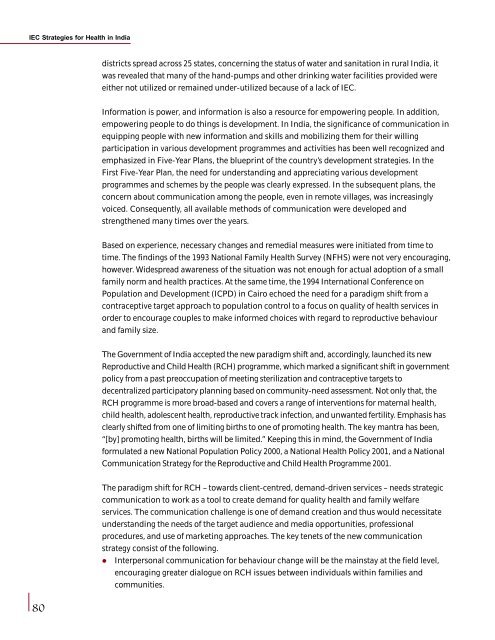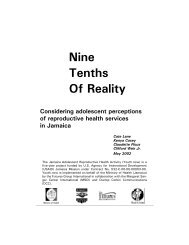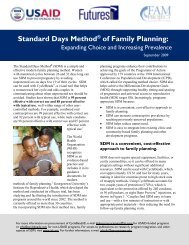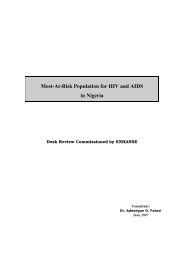Health Policy Issues and Health Programmes in ... - Amazon S3
Health Policy Issues and Health Programmes in ... - Amazon S3
Health Policy Issues and Health Programmes in ... - Amazon S3
- No tags were found...
You also want an ePaper? Increase the reach of your titles
YUMPU automatically turns print PDFs into web optimized ePapers that Google loves.
IEC Strategies for <strong>Health</strong> <strong>in</strong> Indiadistricts spread across 25 states, concern<strong>in</strong>g the status of water <strong>and</strong> sanitation <strong>in</strong> rural India, itwas revealed that many of the h<strong>and</strong>-pumps <strong>and</strong> other dr<strong>in</strong>k<strong>in</strong>g water facilities provided wereeither not utilized or rema<strong>in</strong>ed under-utilized because of a lack of IEC.Information is power, <strong>and</strong> <strong>in</strong>formation is also a resource for empower<strong>in</strong>g people. In addition,empower<strong>in</strong>g people to do th<strong>in</strong>gs is development. In India, the significance of communication <strong>in</strong>equipp<strong>in</strong>g people with new <strong>in</strong>formation <strong>and</strong> skills <strong>and</strong> mobiliz<strong>in</strong>g them for their will<strong>in</strong>gparticipation <strong>in</strong> various development programmes <strong>and</strong> activities has been well recognized <strong>and</strong>emphasized <strong>in</strong> Five-Year Plans, the bluepr<strong>in</strong>t of the country’s development strategies. In theFirst Five-Year Plan, the need for underst<strong>and</strong><strong>in</strong>g <strong>and</strong> appreciat<strong>in</strong>g various developmentprogrammes <strong>and</strong> schemes by the people was clearly expressed. In the subsequent plans, theconcern about communication among the people, even <strong>in</strong> remote villages, was <strong>in</strong>creas<strong>in</strong>glyvoiced. Consequently, all available methods of communication were developed <strong>and</strong>strengthened many times over the years.Based on experience, necessary changes <strong>and</strong> remedial measures were <strong>in</strong>itiated from time totime. The f<strong>in</strong>d<strong>in</strong>gs of the 1993 National Family <strong>Health</strong> Survey (NFHS) were not very encourag<strong>in</strong>g,however. Widespread awareness of the situation was not enough for actual adoption of a smallfamily norm <strong>and</strong> health practices. At the same time, the 1994 International Conference onPopulation <strong>and</strong> Development (ICPD) <strong>in</strong> Cairo echoed the need for a paradigm shift from acontraceptive target approach to population control to a focus on quality of health services <strong>in</strong>order to encourage couples to make <strong>in</strong>formed choices with regard to reproductive behaviour<strong>and</strong> family size.The Government of India accepted the new paradigm shift <strong>and</strong>, accord<strong>in</strong>gly, launched its newReproductive <strong>and</strong> Child <strong>Health</strong> (RCH) programme, which marked a significant shift <strong>in</strong> governmentpolicy from a past preoccupation of meet<strong>in</strong>g sterilization <strong>and</strong> contraceptive targets todecentralized participatory plann<strong>in</strong>g based on community-need assessment. Not only that, theRCH programme is more broad-based <strong>and</strong> covers a range of <strong>in</strong>terventions for maternal health,child health, adolescent health, reproductive track <strong>in</strong>fection, <strong>and</strong> unwanted fertility. Emphasis hasclearly shifted from one of limit<strong>in</strong>g births to one of promot<strong>in</strong>g health. The key mantra has been,“[by] promot<strong>in</strong>g health, births will be limited.” Keep<strong>in</strong>g this <strong>in</strong> m<strong>in</strong>d, the Government of Indiaformulated a new National Population <strong>Policy</strong> 2000, a National <strong>Health</strong> <strong>Policy</strong> 2001, <strong>and</strong> a NationalCommunication Strategy for the Reproductive <strong>and</strong> Child <strong>Health</strong> Programme 2001.80The paradigm shift for RCH – towards client-centred, dem<strong>and</strong>-driven services – needs strategiccommunication to work as a tool to create dem<strong>and</strong> for quality health <strong>and</strong> family welfareservices. The communication challenge is one of dem<strong>and</strong> creation <strong>and</strong> thus would necessitateunderst<strong>and</strong><strong>in</strong>g the needs of the target audience <strong>and</strong> media opportunities, professionalprocedures, <strong>and</strong> use of market<strong>in</strong>g approaches. The key tenets of the new communicationstrategy consist of the follow<strong>in</strong>g.l Interpersonal communication for behaviour change will be the ma<strong>in</strong>stay at the field level,encourag<strong>in</strong>g greater dialogue on RCH issues between <strong>in</strong>dividuals with<strong>in</strong> families <strong>and</strong>communities.







